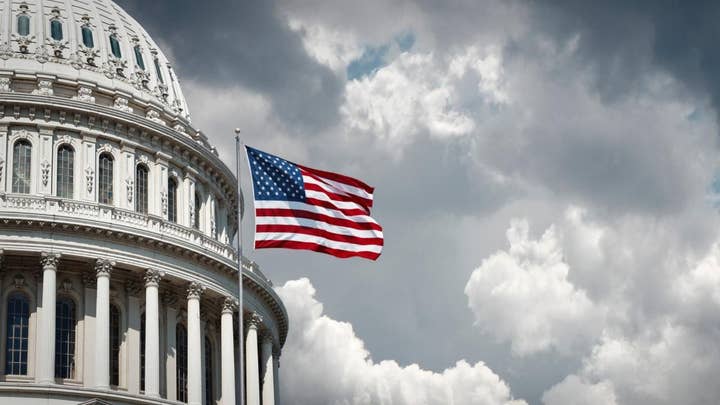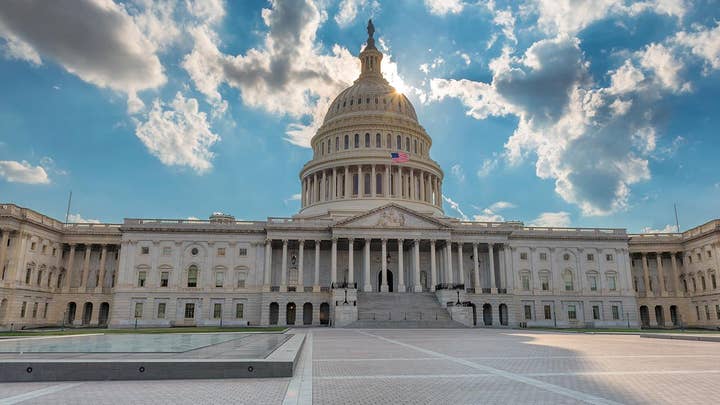Democrats may challenge Pelosi in bid for House speaker
Some Democrats publicly distanced themselves from Nancy Pelosi during midterms campaign; senior Capitol Hill producer Chad Pergram reports.
House Minority Leader Nancy Pelosi is the odds-on favorite to return to the speakership in January when Democrats reclaim control of the House.
But it’s not a done deal for Pelosi.
Yet.
As is always the case on Capitol Hill, it’s about the math, it’s about the math, it’s about the math. It’s not a certainty yet that Pelosi, the California Democrat, has the votes to become speaker. She has some work ahead of her.
Here’s the process:
Democrats will hold their internal leadership elections in less than a month. What Pelosi must do first is command a majority of the Democratic Caucus. Right now Democrats have won at least 225 seats with 13 seats still uncalled. It’s believed Democrats will likely be in the mid-230s when all races are finalized.
Let’s say for the sake of argument Democrats wind up with 233 seats. That means Pelosi, as well as all other lawmakers seeking Democratic leadership positions, need a minimum of 117 votes (one-half of the Democratic Caucus, plus one) to prevail. Achieving 117 should be easy for Pelosi. But the Democratic Caucus doesn’t formally elect the speaker. The entire House votes for speaker on the floor, mostly like at about 1 pm ET on January 3.
The magic number for Pelosi, or anyone else to become speaker, is 218 votes on the floor. From a technical standpoint, the winning candidate for speaker must marshal an absolute majority of all members voting. In other words, the House could be a little smaller than 435 on January 3 if someone hasn’t been sworn-in yet. Lawmakers who vote “present” aren’t counted in the tally. Perhaps there are absences. That means the magic number could be something lower than 218, perhaps 215 or something.
Pelosi has little margin for error. That’s because a number of Representatives-elect have said they would oppose Pelosi: Reps.-elect Jason Crow, D-Colo., Jahana Hayes, D-Conn, Rashia Tlaib, D-Mich., Haley Stevens, D-Mich., Jeff Van Drew, D-N.J., Mikie Sherrill, D-N.J., Max Rose, D-N.Y., Joe Cunningham, D-S.C., Abigail Spanberger, D-Va., Dean Phillips, D-Minn., Colin Allred, D-Texas, Andy Kim, D-N.J., and Elissa Slotkin, D-Mich. There are also a few Democrats who say they would vote against Pelosi from districts with no winner yet.
There are also eight incumbent Democrats who have reservations about Pelosi returning to the speakership: Reps. Kathleen Rice, D-N.Y., Ed Perlmutter, D-Colo., Seth Moulton, D-Mass., Bill Foster, D-Ill., Tim Ryan, D-Ohio, Filemon Vela, D-Texas, Kurt Schrader, D-Ore., and Conor Lamb, D-Pa., Others who may vote against Pelosi are Reps. Jim Cooper, D-Tenn., Brian Higgins, D-N.Y. and Ron Kind, D-Wis.
Let’s say the House is at 233 and the eight incumbents who are no on Pelosi returning to the speakership stick to their guns. That means Pelosi only has a maximum of 225 available votes on the floor. If the 14 Representatives-elect hang together with the eight current members, Pelosi’s number could dwindle to 211, seven short of the 218 threshold.
How does Pelosi make up the prospective deficit? That’s unclear. But Nancy Pelosi is Nancy Pelosi. She has a way knowing exactly what it takes to round up the votes for things. One wonders what persuasive arguments Pelosi might deploy in order to return to the speaker’s suite? What plum committee assignments might she dole out? By the same token, some Democrats whisper that Pelosi is selfish if she goads freshman members from battleground districts to support her – on their very first vote on the House floor.
A vote for speaker could jeopardize these freshmen Democrats right from the start. The National Republican Congressional Committee (NRCC) will have immediate fodder with which to use against those freshmen, based on their first vote on the House floor.
The ads almost write themselves.
That said, one wonders if Pelosi will need 218. It’s possible lawmakers could vote “present” or perhaps not even vote at all. That could help Pelosi.
When the House first crowned Pelosi as speaker in January, 2007, she lost no Democrats. The vote was 233-202. Pelosi returned to the speakership in January, 2009 with a 255-174 tally. But five members didn’t vote. One was Rep. Luis Gutierrez, D-Ill. Gutierrez is retiring and won’t cast a ballot in January.
In January, 2017, Pelosi was the Democratic nominee against house Speaker Paul Ryan, R-Wis. Ryan was poised to win because Republicans were in the majority. Pelosi garnered 189 yeas. But Jim Cooper and Kathleen Rice voted for Tim Ryan. Ron Kind voted for Cooper. Rep. Kyrsten Sinema, D-Ariz., voted for Rep. John Lewis, D-Ga. Among Democrats, moderate Kurt Schrader did not vote.
Perhaps there is something to this idea of voting “present” or just not casting a ballot for speaker at all.
Former Rep. Walt Minnick, D-Idaho, was an unexpected victor in 2008. Minnick won a conservative district which favored Republicans by a staggering 21 points. It was the most-Republican district in the country represented by a Democrat. Minnick knew a vote for Pelosi was toxic in his right-leaning district. Minnick never publicly said anything about how he may vote for speaker - unlike some of this year’s freshmen. But Minnick knew he couldn’t support the San Francisco liberal on his first roll call vote in Congress.
Minnick intended to vote “present.” At the time, a Minnick aide likened the strategy to an “onside kick” in football.
Minnick spoke with Pelosi.
“I said ‘I’m not going to vote for you unless you think it’s harmful for you to be an effective speaker,’” Minnick said. “‘I don’t want to embarrass you.’”
Minnick said Pelosi replied it would damage her, adding “‘I ask you not to do (vote present).’”
Minnick then went to the floor and voted for Pelosi.
He lost in 2010.
“It did hurt me in my re-election,” conceded Minnick. “But I don’t think I would have been re-elected anyway.”
He says they plastered pictures of him and Pelosi together all over his district.
Still, Minnick says the fact that he never commented publicly on his vote for speaker may have given him wiggle room to oppose Pelosi had he seen fit. It’s different for the freshman who are on the record against Pelosi.
“Once they publicly committed, they need not backtrack,” said Minnick.
Rep. Henry Cuellar, D-Texas, is a moderate Democrat who shared the stage with Pelosi at the Democrats’ victory party in Washington Tuesday. Cuellar’s backed Pelosi before. But he’s not committed to her just yet. Cuellar concedes new House Democrats who declared they won’t support Pelosi are in a pickle.
“That is going to be the tricky question,” said Cuellar. “It’s going to be very difficult for some of them.”
Tim Ryan ran against Pelosi in the internal Democratic leadership race in the fall of 2016. But he doesn’t have any plan to challenge Pelosi now.
However, during an appearance on Fox News, Ryan said, “I don’t think this is a done deal yet.” Ryan also says he would “hope somebody does” challenge Pelosi.
But, as they often say on Capitol Hill, you can’t beat somebody with nobody. And so far, no one has emerged to challenge Pelosi for the gavel.
The California Democrat is the only announced candidate for speaker. House Minority Whip Steny Hoyer, D-Md., is the only candidate for House Majority Leader. Assistant Minority Leader Jim Clyburn, D-S.C., is running for majority whip. He faces a challenge from Rep. Diana DeGette, D-Colo. Reps. Hakeem Jeffries, D-N.Y., and Barbara Lee, D-Calif., are now the only candidates for Democratic Caucus Chair. Rep. Linda Sanchez, D-Calif., withdrew because of ethical issues surrounding her husband.
At the celebration Tuesday night, Lujan introduced Pelosi as “the next speaker of the House.” The crowd then boisterously chanted “Spea-KER! Spea-KER! Spea-KER!”
But it may take some jostling for Pelosi to get there.
The key for Pelosi may be keeping others out of the speaker’s race and artfully seeing a number of absences or members voting “present” during the roll call vote in January.
And keep in mind that the House can do nothing until it elects a speaker.
The speaker vote hasn’t gone to a second ballot since 1923. The House finally re-elected Speaker Frederick Gillett, R-Mass., on the ninth ballot after three days of voting.
The House consumed two months and spat out 133 ballots before settling on Nathaniel Banks of Massachusetts in 1856.
And you thought Democrats would start investigating the firing of former Attorney General immediately?
It’s rare for a former speaker to return to the House dais to clasp the gavel. If Pelosi wins the speakership, she’ll be first to rally back in more than half a century. The late House Speaker Sam Rayburn, D-Texas, served as speaker on three separate occasions from the late 1930s through the mid-1960s. Only the late House Speaker Joe Martin, R-Mass., interrupted Rayburn’s streak, claiming the speakership in 1947 and again in 1953.
In the wee hours of Wednesday morning, Pelosi was about to leave the Capitol Hill hotel where Democrats hosted their victory party.
“By the way right now, I’m winning with 87 percent of the vote in my district. Isn’t that wonderful?” Pelosi said.
I asked Pelosi what percentage of House Democrats would support her on the floor.
Pelosi didn’t offer a specific number at that moment.
“I’m ok,” she said, walking away.
It’s unclear what that number is. But you can bet that Pelosi will know soon.
Long before anyone else.








